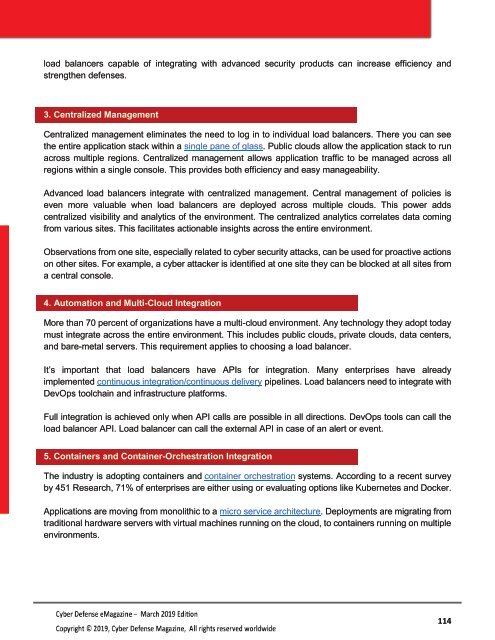CDM-CYBER-DEFENSE-eMAGAZINE-March-2019
You also want an ePaper? Increase the reach of your titles
YUMPU automatically turns print PDFs into web optimized ePapers that Google loves.
load balancers capable of integrating with advanced security products can increase efficiency and<br />
strengthen defenses.<br />
3. Centralized Management<br />
Centralized management eliminates the need to log in to individual load balancers. There you can see<br />
the entire application stack within a single pane of glass. Public clouds allow the application stack to run<br />
across multiple regions. Centralized management allows application traffic to be managed across all<br />
regions within a single console. This provides both efficiency and easy manageability.<br />
Advanced load balancers integrate with centralized management. Central management of policies is<br />
even more valuable when load balancers are deployed across multiple clouds. This power adds<br />
centralized visibility and analytics of the environment. The centralized analytics correlates data coming<br />
from various sites. This facilitates actionable insights across the entire environment.<br />
Observations from one site, especially related to cyber security attacks, can be used for proactive actions<br />
on other sites. For example, a cyber attacker is identified at one site they can be blocked at all sites from<br />
a central console.<br />
4. Automation and Multi-Cloud Integration<br />
More than 70 percent of organizations have a multi-cloud environment. Any technology they adopt today<br />
must integrate across the entire environment. This includes public clouds, private clouds, data centers,<br />
and bare-metal servers. This requirement applies to choosing a load balancer.<br />
It’s important that load balancers have APIs for integration. Many enterprises have already<br />
implemented continuous integration/continuous delivery pipelines. Load balancers need to integrate with<br />
DevOps toolchain and infrastructure platforms.<br />
Full integration is achieved only when API calls are possible in all directions. DevOps tools can call the<br />
load balancer API. Load balancer can call the external API in case of an alert or event.<br />
5. Containers and Container-Orchestration Integration<br />
The industry is adopting containers and container orchestration systems. According to a recent survey<br />
by 451 Research, 71% of enterprises are either using or evaluating options like Kubernetes and Docker.<br />
Applications are moving from monolithic to a micro service architecture. Deployments are migrating from<br />
traditional hardware servers with virtual machines running on the cloud, to containers running on multiple<br />
environments.<br />
114



